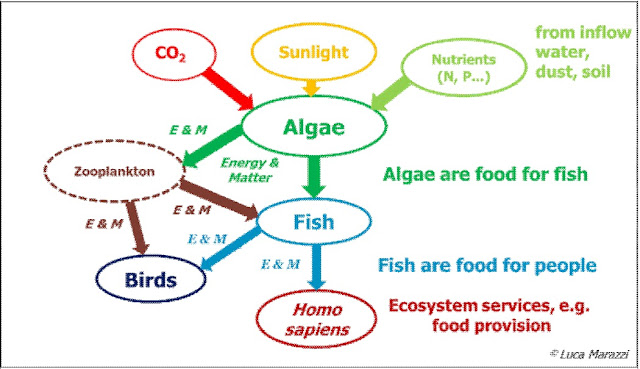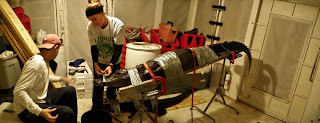Diatom of the month – April 2016: Cocconeis placentula
by Luca Marazzi*
‘Who’
is it and where does it live?
Cocconeis placentula / C. lineata from a 2003 Everglades sample (Dr. Evelyn Gaiser Lab photo archive).
Valve with (left) and
without (right) raphe (http://westerndiatoms.colorado.edu/; scalebar: 10 µm). Recent taxonomic work suggests that this be named C. euglypta (pers. comm. Tom Frankovich)2.
Like many other diatoms that are adapted to specific environmental conditions, Cocconeis placentula, is a freshwater epiphytic species that tolerates high salinity levels in the water. Why? A 2013 study on the Coroong wetlands (Australia) suggests that this diatom (and C. pinnata) is capable of regulating the size of its pore holes which control nutrient flows between the cells and the environment3. With higher concentrations of salt, this diatom basically spits out the ions in excess from aptly enlarged pores.
Why
are we studying it?
Algae
such as our diatoms of the month are extremely useful indicators or sentinels
of the environmental changes occurring in freshwater ecosystems, including (as
by now you know, if you read previous posts) the
Florida Everglades. A recent study on sediment cores collected in this
wetland’s marshes identified several species best adapted to shallow habitats
with short hydroperiod (the number of days during which a site is flooded /
wet), e.g. Nitzschia serpentiraphe, Achnanthidium minutissimum, and C. placentula, that were most abundant in shallow water / short hydroperiod
habitats (<38 cm; <300 days), as opposed to deeper water / long
hydroperiod habitats (>46 cm; >400 days), which were preferred by other
taxa such as Eunotia flexuosa and Encyonema evergladianum4. So data on these microalgae,
together with key hydrological and water quality information, can improve our understanding
of the effects of water flow changes in the Everglades. The impacts of
large-scale canalizations and water retention schemes - to respectively irrigate
crops and protect cities from either floods or droughts – on the ecosystem –
and that of restoration projects to enhance water flow to natural areas have
been monitored for many years. Measuring and estimating past and present
environmental conditions is crucial to provide South Florida water managers and
state and federal agency policy makers with realistic scenarios of what the marshes
and prairies will look like in the years to come, subject to different natural
conditions and human choices. These models are then used by organizations such
as the South Florida Water Management District, and the US Army Corps of Engineers,
for example to
increase the important flows of freshwater to Everglades National Park (“The largest
subtropical wilderness in the United States”).
Faculty and staff members of FIU,
South Florida Water Management District, and US Army Corps of Engineers near a
large tree island during an official visit to Water Conservation Area 3A
(November 2015).
1.
Source: http://westerndiatoms.colorado.edu/taxa
2. Romero
O.E., Jahn R. (2013) Typification
of Cocconeis lineata and Cocconeis euglypta. Diatom Research,
28, 175–184.
3. Leterme S.C., Prime E.,
Mitchell J., Brown M.H., Ellis A.V. Diatom adaptability to environmental change: a case study of two Cocconeis species from high-salinity
areas. Diatom Research, 28, 29–35.
4. Sanchez C.,
Gaiser E.E., Saunders C.J., Wachnicka A.H., Oehm N., Craft C. (2013) Challenges in
using siliceous subfossils as a tool for inferring past water level and hydroperiod in
Everglades marshes.
Journal of Paleolimnology, 49, 45–66.





Comments
Post a Comment